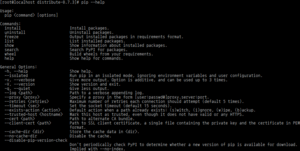Pip (package manager)

An output of
pip --help
|
|
| Initial release | 4 April 2011 |
|---|---|
| Stable release |
9.0.1 / 6 November 2016
|
| Repository | github |
| Written in | Python |
| Operating system | OS-independent |
| Platform | Python |
| Type | Package management system |
| License | Free software |
| Website | pip |
pip is a package management system used to install and manage software packages written in Python. Many packages can be found in the Python Package Index (PyPI).
Python 2.7.9 and later (on the python2 series), and Python 3.4 and later include pip (pip3 for Python 3) by default.
pip is a recursive acronym that can stand for either "Pip Installs Packages" or "Pip Installs Python".
Most distributions of Python come with pip preinstalled. If pip is missing, it can be installed through the system package manager or by invoking cURL, a client-side data transfer tool:
One major advantage of pip is the ease of its command-line interface, which makes installing Python software packages as easy as issuing one command:
Users can also easily remove the package:
Most importantly pip has a feature to manage full lists of packages and corresponding version numbers, possible through a "requirements" file. This permits the efficient re-creation of an entire group of packages in a separate environment (e.g. another computer) or virtual environment. This can be achieved with a properly formatted requirements.txt file and the following command:
Install some package for a specific version python, where ${version} is replaced for 2, 3, 3.4, etc.:
Pip is used to support the use of Python in cloud web hosting, such as by Heroku.
...
Wikipedia
